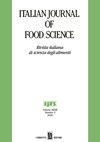咖啡粉提取物在食品和营养保健工业中可能是一种有用的功能性成分吗?
IF 3.3
4区 农林科学
Q2 FOOD SCIENCE & TECHNOLOGY
引用次数: 4
摘要
本研究旨在评估具有不同地理来源的阿拉比卡(A)和/或罗布斯塔(R)咖啡粉的乙醇提取物的植物化学含量和体外生物活性。为此,对总酚(TPC)和类黄酮(TFC)含量以及α-和β-生育酚进行了定量。采用多靶点方法评估抗氧化活性,其中应用了自由基清除潜力、脂质过氧化保护和铁还原机制。还测定了碳水化合物水解酶(α-淀粉酶和α-葡萄糖苷酶)的抑制活性。阿拉比卡咖啡样品(C2-A)显示出最高的TPC、TFC和α-生育酚含量,其值分别为63.1 mg绿原酸当量(CAE)/g干粉、16.2 mg槲皮素当量/g干粉和5.6 mg/100 g干粉。相对抗氧化能力指数(RACI),用于统计整合2,2'-叠氮基双(3-乙基苯并噻唑啉-6-磺酸)二铵盐(ABTS)、2,2-二苯基-1-苦基肼(DPPH)、铁还原能力(FRAP)和脂质过氧化保护测定的结果,证明来自危地马拉罗布斯塔的样品C4-R显示出最高的抗氧化潜力,其值为-0.61。来自波多黎各的阿拉比卡对α-淀粉酶的活性最高,而阿拉比卡/罗布斯塔混合物样品(C5-A60R40)对α-葡萄糖苷酶的抑制活性最高,IC50值分别为120.2和134.6 mg/mL。结果表明,提取物的定性-定量组成不仅与样品的种类密切相关,而且与样品的地理来源密切相关。本文章由计算机程序翻译,如有差异,请以英文原文为准。
Is coffee powder extract a possible functional ingredient useful in food and nutraceutical industries?
The present study aimed to assess the phytochemical content and in vitro bioactivity of ethanolic extracts of Arabica (A) and/or Robusta (R) coffee powder having different geographical origins. For this purpose, total phenols (TPC) and flavonoids (TFC) content as well as α- and β-tocopherol were quantified. The antioxidant activity was assessed by using a multi-target approach in which the radical scavenging potential, the protection from lipid peroxidation, and the involvement of the iron-reducing mechanism were applied. The carbohydrate hydrolyzing enzymes’ (α-amylase and α-glucosidase) inhibitory activities were also assessed. Arabica coffee sample (C2-A) showed the highest TPC, TFC, and α-tocopherol content with values of 63.1 mg chlorogenic acid equivalents (CAE)/g dry powder, 16.2 mg of quercetin (QE) equivalents/g dry powder, and 5.6 mg/100 g dry powder, respectively. Relative Antioxidant Capacity Index (RACI), used to statistically integrate results from 2,2'-azino-bis(3-ethylbenzothiazoline-6-sulfonic acid) diammonium salt (ABTS), 2,2-diphenyl-1-picrylhydrazyl (DPPH), ferric reducing ability power (FRAP), and protection of lipid peroxidation assays, evidenced that sample C4-R derived from Robusta from Guatemala showed the highest antioxidant potential with a value of –0.61. Arabica from Puerto Rico was the most active against α-amylase, whereas the blend Arabica/Robusta sample (C5-A60R40) showed the highest inhibitory activity against α-glucosidase with IC50 values of 120.2 and 134.6 mg/mL, respectively. The results show how the qualitative-quantitative composition of the extracts is strongly associated not only with the variety but also with the geographical origin of the samples.
求助全文
通过发布文献求助,成功后即可免费获取论文全文。
去求助
来源期刊

Italian Journal of Food Science
工程技术-食品科技
CiteScore
4.20
自引率
0.00%
发文量
33
审稿时长
>36 weeks
期刊介绍:
"Italian Journal of Food Science" is an international journal publishing original, basic and applied papers, reviews, short communications, surveys and opinions on food science and technology with specific reference to the Mediterranean Region. Its expanded scope includes food production, food engineering, food management, food quality, shelf-life, consumer acceptance of foodstuffs, food safety and nutrition, energy and environmental aspects of food processing on the whole life cycle.
Reviews and surveys on specific topics relevant to the advance of the Mediterranean food industry are particularly welcome.
 求助内容:
求助内容: 应助结果提醒方式:
应助结果提醒方式:


